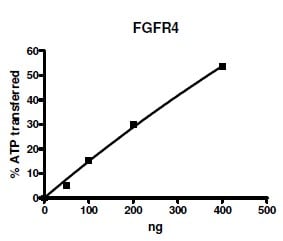Recombinant human FGFR4 protein (ab135023)
Key features and details
- Expression system: Baculovirus infected Sf9 cells
- Purity: >= 75% SDS-PAGE
- Active: Yes
- Tags: GST tag N-Terminus
- Suitable for: Functional Studies, SDS-PAGE
-
Product name
Recombinant human FGFR4 protein
See all FGFR4 proteins and peptides -
Biological activity
Specific Activity: 50 pmole/min/µg
Assay Conditions: Reaction is conducted in a Kinase Buffer (50 mM Tris pH 7.4, 20 mM MgCl2, 0.1 mg/ml BSA and 1 mM DTT) containing 20 µM ATP and 0.2 mg/ml poly-(Glu-Tyr) for 30 min at 30 °C. -
Purity
>= 75 % SDS-PAGE. -
Expression system
Baculovirus infected Sf9 cells -
Accession
-
Protein length
Protein fragment -
Animal free
No -
Nature
Recombinant -
-
Species
Human -
Predicted molecular weight
65 kDa including tags -
Amino acids
460 to 802 -
Tags
GST tag N-Terminus
-
Preparation and Storage
-
Alternative names
- CD 334
- CD334
- CD334 antigen
see all -
Function
Receptor for acidic fibroblast growth factor. Does not bind to basic fibroblast growth factor. Binds FGF19. -
Tissue specificity
Expressed in gastrointestinal epithelial cells, pancreas, and gastric and pancreatic cancer cell lines. -
Sequence similarities
Belongs to the protein kinase superfamily. Tyr protein kinase family. Fibroblast growth factor receptor subfamily.
Contains 3 Ig-like C2-type (immunoglobulin-like) domains.
Contains 1 protein kinase domain. -
Post-translational
modificationsGlycosylated.
Phosphorylated on tyrosine residue (By similarity). Phosphorylation requires the presence of a functional (phosphorylated) FGFR1 and not necessarily by means of FGFR heterodimerization. -
Cellular localization
Membrane. Isoform 2 may be secreted. - Information by UniProt












